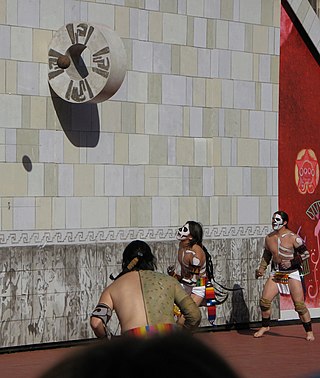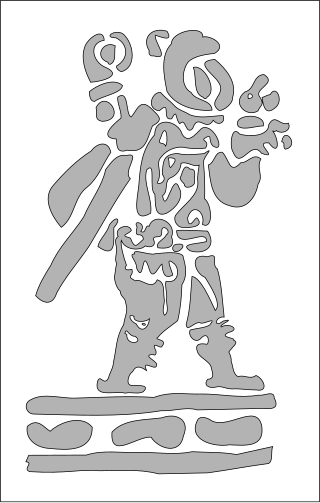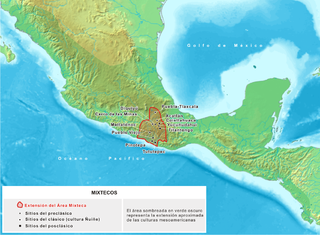
Oaxaca, officially the Free and Sovereign State of Oaxaca, is one of the 32 states that compose the Federative Entities of the United Mexican States. It is divided into 570 municipalities, of which 418 are governed by the system of usos y costumbres with recognized local forms of self-governance. Its capital city is Oaxaca de Juárez.

The Mesoamerican ballgame was a sport with ritual associations played since at least 1650 BC by the pre-Columbian people of Ancient Mesoamerica. The sport had different versions in different places during the millennia, and a modernized version of the game, ulama, is still played by the indigenous populations in some places.

Jeu de paume, nowadays known as real tennis, (US) court tennis or courte paume, is a ball-and-court game that originated in France. It was an indoor precursor of tennis played without racquets, and so "game of the hand", though these were eventually introduced. It is a former Olympic sport, and has the oldest ongoing annual world championship in sport, first established over 250 years ago. The term also refers to the court on which the game is played and its building, which in the 17th century was sometimes converted into a theatre.

Ollama is a ball game played in Mexico, currently experiencing a revival from its home in a few communities in the state of Sinaloa. As a descendant of the Aztec version of the Mesoamerican ballgame, the game is regarded as one of the oldest continuously played sports in the world and as the oldest known game using a rubber ball.

Basque pelota is the name for a variety of court sports played with a ball using one's hand, a racket, a wooden bat or a basket, against a wall or, more traditionally, with two teams face to face separated by a line on the ground or a net. The roots of this class of games can be traced to the Greek and other ancient cultures.

The Mixtec languages belong to the Mixtecan group of the Oto-Manguean language family. Mixtec is spoken in Mexico and is closely related to Trique and Cuicatec. The varieties of Mixtec are spoken by over half a million people. Identifying how many Mixtec languages there are in this complex dialect continuum poses challenges at the level of linguistic theory. Depending on the criteria for distinguishing dialects from languages, there may be as few as a dozen or as many as fifty-three Mixtec languages.

Paleta frontón is a Peruvian sport that was born in the capital, Lima, in 1945. This sport has its roots in the "pelota vasca" brought by the Spanish settlers, and the domestic "pelota mano", called "handball" at that time due to English influence. The sport is similar to squash but is played on an open court.
The International Ball game Confederation, founded on May 13, 1928, is the organization that manages the common activities of the many ball games deriving from Jeu de paume.

Ancient Mesoamericans were the first people to invent rubber balls, sometime before 1600 BCE, and used them in a variety of roles. The Mesoamerican ballgame, for example, employed various sizes of solid rubber balls and balls were burned as offerings in temples, buried in votive deposits, and laid in sacred bogs and cenotes.

Dainzú is a Zapotec archaeological site located in the eastern side of the Valles Centrales de Oaxaca, about 20 km south-east of the city of Oaxaca, Oaxaca State, Mexico. It is an ancient village near to and contemporary with Monte Albán and Mitla, with an earlier development. Dainzú was first occupied 700-600 BC but the main phase of occupation dates from about 200 BC to 350 AD. The site was excavated in 1965 by Mexican archaeologist Ignacio Bernal.
San Juan Achiutla is a town and municipality in Oaxaca in south-western Mexico. The municipality covers an area of 49.76 km2. It is located in a mountain range, between the hills Negro to the East, Yucuquise to the Northwest, Cuate to the North and Totolote to the South. It is crossed by the river Los Sabinos and has a dam called Cahuayande. Its weather is temperate. It is in the Mixteca Alta, one of the three parties that make up the Mixteca region and in the Mixteca Alta is part of what was Achiutla, the significant Prehispanic place.

Cerro de la Minas is an archaeological site located in the modern state of Oaxaca, just to the north of the city of Huajuapan de León. The site belongs to what is called the Ñuiñe, or lowland/hot lands Mixtec cultural area. The site is located on a hill that dominates the Valley of Huajuapan, in what are now the neighborhoods of Chapultepec, Santa Rosa, Alta Vista and Del Maestro of the city. This large hill is in a strategic position over the farmlands of the valley, which provided it with its food, as well as the trade routes that cross this valley, which made it regionally important. The site contains a number of settlements and was reserved for the elite of that area during that time. Cerro de las Minas is the only lowland Mixtec archeological site open to the public.

Huamelulpan is an archaeological site of the Mixtec culture, located in the town of San Martín Huamelulpan at an elevation of 2,218 metres (7,277 ft), about 96 kilometres (60 mi) north-west of the city of Oaxaca, the capital of Oaxaca state.

The Chaza, or pelota nacional, is a South American racquet sport,, which is practiced on a rectangular area bounded by lines. This area is divided by a line drawn on the floor that divides the playing field. It is played between two teams, each with 4 players. The object of the game is to launch a ball by hand or racquet so that it bounces into the opponent's field without being returned.

Regional communications in ancient Mesoamerica are believed to have been extensive. There were various trade routes attested since prehistoric times. In this article, especially the routes starting in the Mexico Central Plateau, and going down to the Pacific coast will be considered. These contacts then went on as far as Central America.

Pelota purépecha, called Uárukua Ch'anakua in the Purépecha language, is an Indigenous Mexican sport similar to those in the hockey family. A common variant, distinguished as pasárutakua in Purépecha, uses a ball which has been set on fire and can be played at night. It has a league, several practicing communities and about 800 players across Mexico as of 2010. It is one of 150 pre-Hispanic Mexican games at risk of dying out along with Ulama.
Timbomba is a traditional game played in the center and south of Mexico. Originally it was played by Maya children. This game is mainly played by children over 6 years. To play timbomba one needs a place without obstacles and two round sticks: a 10 in long stick and a 5 in long conical stick with tips. A player stands in a base similar to a baseball base, then, he takes the longer stick and hits the kimbomba, which is on the ground. The shorter stick is raised and the player hits it again, like a baseball. There are two versions but in both it is necessary to get the stick as far away as possible. At least two players are needed.

The Mixtec culture was a pre-hispanic archaeological culture, corresponding to the ancestors of the Mixtec people; they called themselves ñuu Savi, which means "people or nation of the rain". It had its first manifestations in the Mesoamerican Middle Preclassic period and ended with the Spanish conquest in the first decades of the 16th century. The historical territory of this people is the area known as La Mixteca, a mountainous region located between the current Mexican states of Puebla, Oaxaca, and Guerrero.
Mexico has some traditional games and activities.
















